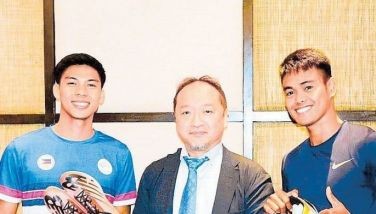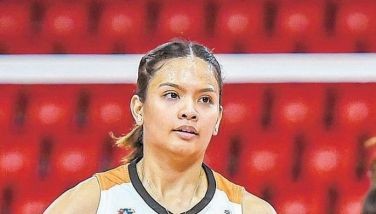How RP has fared through the years

November 26, 2006 | 12:00am
(Editor’s note: The following is the second of a series of articles on the Philippines campaign in the 15th Asian Games scheduled December 1-15 in Doha, Qatar.)
It hasn’t been a bed of roses for the Philippines in vying for honors in the Asian Games, the so-called Olympics of Asia held once every four years.
In 14 stagings of the event, the Philippines has bagged only 56 gold medals compared to China’s 840. Boxing has contributed the most first-place finishes for the country in Asiad history — 12, including five in 1954 and three in 1994. Athletics is next with 11. Others in the honor roll are swimming (10), shooting (6), bowling (6), basketball (4), tennis (3), billiards (2) and golf (1).
But since fighters Mansueto (Onyok) Velasco, Elias Recaido and Reynaldo Galido struck gold in Hiroshima in 1994, boxing has been a disappointment in the Asian Games. In Bangkok in 1998, only Eric Canoy brought back a medal — a bronze aftrer losing to Tuyikonbav Turgunov in the featherweight finals. Four years ago in Busan, lightflyweight Harry Tañamor was the only medalist with a silver.
The Philippines’ shiningest performance in the Asiad came in the second edition here in 1954. Filipinos captured 14 golds — their most ever — and basketball showed the way as the host nation also collected 14 silvers and 17 bronzes to place second overall behind Japan.
The cage heroes were Caloy Loyzaga, Tony Genato, Nap Flores, Bay Mumar, Eddie Lim, Francisco Rabat, Ning Ramos, Bayani Amador, Florentino Bautista, Jose Ma. Cacho, Paeng Hechanova, Mon Manulat and Pons Saldana. Coach was Herr Silva.
Five fighters also trooped to the dais to pocket golds — flyweight Ernesto Sajo, bantamweight Alejandro Ortuoste, lightweight Celedonio Espinosa, lightwelterweight Ernesto Porto and middleweight Vicente Tunacao. Swimmer Haydee Coloso-Espino claimed golds in the 100-meter freestyle and butterfly. She would later enter the record books as the most bemedalled national athlete in the Asian Games, claiming three golds, five silvers and two bronzes in swimming in 1954, 1958 and 1962.
Two other tankers who won golds in 1954 were 100-meter backstroker Jocelyn Von Giese and 200-meter butterflyer Parsons Nabuila. The other gold medalists were shooters Chito Feliciano, Martin Gison, Albert Von Einsiedel and Hernando Castelo.
That year, the Asian Games brought in only 970 athletes from 19 countries and 12 sports were in the calendar. Boxing, rifle shooting and wrestling were introduced in the program.
At the 1951 Asiad inaugurals in New Delhi, only 500 athletes from 11 countries participated in six sports, namely, athletics, basketball, cycling, football, swimming and weightlifting where 54 gold medals were on the line.
The Philippines finished fifth overall with five gold, six silver and eight bronze medals. The Filipino gold medalists were high jumper Andy Franco, swimmer Jacinto Cayco (200-meter breaststroke and 3x10 100-meter medley), swimmer Artemio Salamat (100-meter breaststroke) and the basketball team composed of Kiko Calilan, Andy de la Cruz, Genaro Fernandez, Jose Gochangco, Hechanova, Luis Lorenzo, Loyzaga, Pocholo Martinez, Mumar, Ramos, Meliton Santos and Nano Tolentino. The cagers were coached by Chito Calvo.
In 1958, over 1,400 athletes from 20 countries competed in the third Asian Games in Tokyo. Tennis, volleyball, table tennis, cycling and hockey increased the calendar to 13 sports.
As expected, Japan won its third overall title in a row with the Philippines placing second. The distance, however, was wide as Japan took 67 of the 110 gold medals at stake and the Philippines grabbed only nine. Filipino cagers, piloted by Tito Eduque, continued to dominate and won their third consecutive gold medal behind Loyzaga, Emilio Achacoso, Kurt Bachmann, Charlie Badion, Bonnie Carbonell, Francisco Lagarejos, Eddie Lim, Manulat, Leonardo Marquicias, Constancio Ortiz, Tolentino, Martin Urra, Antonio Villamor and Francis Wilson.
The Philippines slipped to fourth overall in 1962 with Jakarta as host. Filipino athletes garnered seven gold, four silver and 16 bronze medals. There were 1,460 athletes from 16 countries in the 15-sport joust where Japan bagged top honors with 73 gold medals of 113 at stake. Once again, the basketball team delivered but it proved to be the last gold medal ever from the sport that Filipinos love with a passion. The squad was made up of Narciso Bernardo, Bachmann, Gerry Cruz, Boy Arazas, Manny Jocson, Loyzaga, Boy Marquez, Roehl Nadurata, Eddie Pacheco, Cristobal Ramas, Big Boy Reynoso and Ed Roque. Coach was Enrique Crame.
Other gold medalists were tracksters Isaac Gomez, Aida Molinos and Mona Sulaiman (two), welterweight boxer Manfredo Alipala and tennis ace Johnny Jose.
In 1966, the Philippines fell to 10th place with two gold, 15 silver and 25 bronze medals in Bangkok. Only discus thrower Josephine de la Vina and lightweight boxer Rodolfo Arpon hit paydirt. The consolation was the Philippines collected 42 total medals, the third most among 18 nations behind only Japan with 164 and South Korea with 51.
The basketeers, coached by Fely Fajardo, wound up sixth despite a star-studded cast that included Danny Florencio, Robert Jaworski, Jimmy Mariano, Jake Rojas and Ed Ocampo. Israel, now competing in Europe, won the gold medal.
South Korea was supposed to host the next Asiad in 1970 but political turmoil brought the Games back to Bangkok. Some 2,500 athletes from 18 countries participated in 13 sports with 137 gold medals on the line. Yachting was introduced in the program.
The Philippines limped home in 11th place with a single gold medal from bantamweight boxer Ricardo Fortaleza. The haul included nine silver and 12 bronze medals.
Baby Dalupan coached the basketball team to fifth spot. His players included Jaworski, Orly Bauzon, Rudy Kutch, Freddie Webb, Florencio, Manny Jocson, Johnny Revilla and Rudy Soriano.
Then came the wipeout in 1974. For the first and only time in the Asiad, the Philippines failed to snare a single gold medal. The black mark in the country’s Asian Games history was registered in Tehran. Ral Rosario was the lone Filipino hero that dark year as he swam to a pair of silvers in the 100-meter and 200-meter backstroke.
China made its Asian Games debut with 32 gold medals and a second place finish. Over 3,000 athletes showed up from 25 countries to participate in 16 sports with 186 gold medals up for grabs. The Philippines dropped to an all-time low of 15th place in the overall standings.
It hasn’t been a bed of roses for the Philippines in vying for honors in the Asian Games, the so-called Olympics of Asia held once every four years.
In 14 stagings of the event, the Philippines has bagged only 56 gold medals compared to China’s 840. Boxing has contributed the most first-place finishes for the country in Asiad history — 12, including five in 1954 and three in 1994. Athletics is next with 11. Others in the honor roll are swimming (10), shooting (6), bowling (6), basketball (4), tennis (3), billiards (2) and golf (1).
But since fighters Mansueto (Onyok) Velasco, Elias Recaido and Reynaldo Galido struck gold in Hiroshima in 1994, boxing has been a disappointment in the Asian Games. In Bangkok in 1998, only Eric Canoy brought back a medal — a bronze aftrer losing to Tuyikonbav Turgunov in the featherweight finals. Four years ago in Busan, lightflyweight Harry Tañamor was the only medalist with a silver.
The Philippines’ shiningest performance in the Asiad came in the second edition here in 1954. Filipinos captured 14 golds — their most ever — and basketball showed the way as the host nation also collected 14 silvers and 17 bronzes to place second overall behind Japan.
The cage heroes were Caloy Loyzaga, Tony Genato, Nap Flores, Bay Mumar, Eddie Lim, Francisco Rabat, Ning Ramos, Bayani Amador, Florentino Bautista, Jose Ma. Cacho, Paeng Hechanova, Mon Manulat and Pons Saldana. Coach was Herr Silva.
Five fighters also trooped to the dais to pocket golds — flyweight Ernesto Sajo, bantamweight Alejandro Ortuoste, lightweight Celedonio Espinosa, lightwelterweight Ernesto Porto and middleweight Vicente Tunacao. Swimmer Haydee Coloso-Espino claimed golds in the 100-meter freestyle and butterfly. She would later enter the record books as the most bemedalled national athlete in the Asian Games, claiming three golds, five silvers and two bronzes in swimming in 1954, 1958 and 1962.
Two other tankers who won golds in 1954 were 100-meter backstroker Jocelyn Von Giese and 200-meter butterflyer Parsons Nabuila. The other gold medalists were shooters Chito Feliciano, Martin Gison, Albert Von Einsiedel and Hernando Castelo.
That year, the Asian Games brought in only 970 athletes from 19 countries and 12 sports were in the calendar. Boxing, rifle shooting and wrestling were introduced in the program.
At the 1951 Asiad inaugurals in New Delhi, only 500 athletes from 11 countries participated in six sports, namely, athletics, basketball, cycling, football, swimming and weightlifting where 54 gold medals were on the line.
The Philippines finished fifth overall with five gold, six silver and eight bronze medals. The Filipino gold medalists were high jumper Andy Franco, swimmer Jacinto Cayco (200-meter breaststroke and 3x10 100-meter medley), swimmer Artemio Salamat (100-meter breaststroke) and the basketball team composed of Kiko Calilan, Andy de la Cruz, Genaro Fernandez, Jose Gochangco, Hechanova, Luis Lorenzo, Loyzaga, Pocholo Martinez, Mumar, Ramos, Meliton Santos and Nano Tolentino. The cagers were coached by Chito Calvo.
In 1958, over 1,400 athletes from 20 countries competed in the third Asian Games in Tokyo. Tennis, volleyball, table tennis, cycling and hockey increased the calendar to 13 sports.
As expected, Japan won its third overall title in a row with the Philippines placing second. The distance, however, was wide as Japan took 67 of the 110 gold medals at stake and the Philippines grabbed only nine. Filipino cagers, piloted by Tito Eduque, continued to dominate and won their third consecutive gold medal behind Loyzaga, Emilio Achacoso, Kurt Bachmann, Charlie Badion, Bonnie Carbonell, Francisco Lagarejos, Eddie Lim, Manulat, Leonardo Marquicias, Constancio Ortiz, Tolentino, Martin Urra, Antonio Villamor and Francis Wilson.
The Philippines slipped to fourth overall in 1962 with Jakarta as host. Filipino athletes garnered seven gold, four silver and 16 bronze medals. There were 1,460 athletes from 16 countries in the 15-sport joust where Japan bagged top honors with 73 gold medals of 113 at stake. Once again, the basketball team delivered but it proved to be the last gold medal ever from the sport that Filipinos love with a passion. The squad was made up of Narciso Bernardo, Bachmann, Gerry Cruz, Boy Arazas, Manny Jocson, Loyzaga, Boy Marquez, Roehl Nadurata, Eddie Pacheco, Cristobal Ramas, Big Boy Reynoso and Ed Roque. Coach was Enrique Crame.
Other gold medalists were tracksters Isaac Gomez, Aida Molinos and Mona Sulaiman (two), welterweight boxer Manfredo Alipala and tennis ace Johnny Jose.
In 1966, the Philippines fell to 10th place with two gold, 15 silver and 25 bronze medals in Bangkok. Only discus thrower Josephine de la Vina and lightweight boxer Rodolfo Arpon hit paydirt. The consolation was the Philippines collected 42 total medals, the third most among 18 nations behind only Japan with 164 and South Korea with 51.
The basketeers, coached by Fely Fajardo, wound up sixth despite a star-studded cast that included Danny Florencio, Robert Jaworski, Jimmy Mariano, Jake Rojas and Ed Ocampo. Israel, now competing in Europe, won the gold medal.
South Korea was supposed to host the next Asiad in 1970 but political turmoil brought the Games back to Bangkok. Some 2,500 athletes from 18 countries participated in 13 sports with 137 gold medals on the line. Yachting was introduced in the program.
The Philippines limped home in 11th place with a single gold medal from bantamweight boxer Ricardo Fortaleza. The haul included nine silver and 12 bronze medals.
Baby Dalupan coached the basketball team to fifth spot. His players included Jaworski, Orly Bauzon, Rudy Kutch, Freddie Webb, Florencio, Manny Jocson, Johnny Revilla and Rudy Soriano.
Then came the wipeout in 1974. For the first and only time in the Asiad, the Philippines failed to snare a single gold medal. The black mark in the country’s Asian Games history was registered in Tehran. Ral Rosario was the lone Filipino hero that dark year as he swam to a pair of silvers in the 100-meter and 200-meter backstroke.
China made its Asian Games debut with 32 gold medals and a second place finish. Over 3,000 athletes showed up from 25 countries to participate in 16 sports with 186 gold medals up for grabs. The Philippines dropped to an all-time low of 15th place in the overall standings.
BrandSpace Articles
<
>
- Latest
- Trending
Trending
Latest
Trending
Latest
Recommended
























